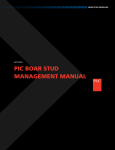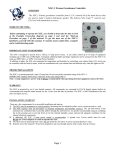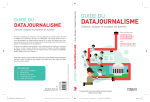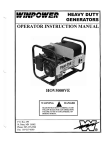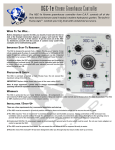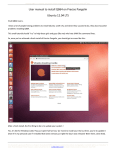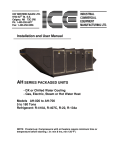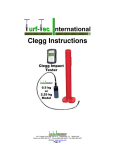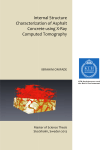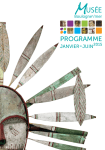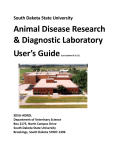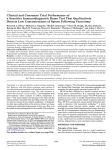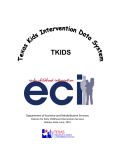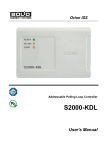Download Boar Stud Management Manual
Transcript
Boar Stud Management Manual ©2013 PIC All Rights Reserved. PIC Boar Stud Management Manual Never Stop Improving Table of Contents Table of Contents List of Figures, Pictures, and Tables...........................................................................2 Introduction…………………………………………………………………………...........3 Part 1. General Anatomy and Physiology…………………………………………........5 Part 2. Isolation and Acclimation…………………………………………………...........8 Part 3. General Management of Boars…………………………………………..........11 Part 4. Barn Management……………………………………………………...............12 Part 5. Ventilation and Air Flow…………………………………………………….......14 Part 6. Body Condition……………………………………………………………..........18 Part 7. Feeding and Nutrition…………………………………………………..............19 Part 8. Training……………………………………………………………………….......21 Training for Manual Collection....................................................................21 Training Using an Automated Collection System.......................................22 Part 9. Boar Collection……………………………………………………………..........23 Part 10. Welfare and Health………………………………………………………….....25 Body Temperature and Appetite.................................................................25 Diagnostic Testing......................................................................................25 Criteria for Stud Closure.............................................................................26 Handling and Euthanasia...........................................................................26 Transport of Boars......................................................................................27 Part 11. Laboratory Management………………………………………………….......28 Water Quality..............................................................................................29 Semen Arrival.............................................................................................30 Semen Assessment...................................................................................30 Concentration Assessment........................................................................31 Semen Extension.......................................................................................32 Dispensing Semen Doses..........................................................................32 Semen Cooling and Packing of Cooled Doses.........................................33 Semen Shipping and Transport..................................................................33 Part 12. Quality Control……………………………………………………………........34 Part 13. Personnel Management and Training........................................................39 Part 14. Key Performance Indicators………………………………………………......40 Part 15. Production Benchmarks…………………………………………………........41 Part 16. Boar Life and Replacement Rate……………………………………….........44 References……………………………………………………………….......................45 Contributors…………………………………………………………………………........46 Appendix A. Nutrient Requirements for Swine……………………………………......47 Appendix B. PIC Minimum Diet Specifications and Example Boar Diet……….......48 Appendix C. Automated Collection Systems Step-by-Step Instructions for Use.....49 Appendix D. Packaging Semen Doses for Shipment Using Double Coolers……...52 Appendix E. Extender Preparation Guide…………………………………………......55 Appendix F. Water Sample Preparation for Third Party Analysis…………………...56 1 PIC Boar Stud Management Manual List of Figures, Pictures and Tables List of Figures, Pictures and Tables Figure 1. Schematic of hormone production and regulation in sperm production............................5 Table 1. Process of boar maturation……………………………….................…………………………6 Picture 1. Flow of sperm production…………………………………..............................................…6 Picture 2. Reproductive organs in the boar……………………………………………..........…………7 Table 2. Management factors that impact semen quality………………………………................…13 Table 3. Building environment variables and recommended optimized conditions…..............……14 Figure 2. Variable fan speed as it relates to CFM………………………………....................………15 Table 4. Estimations of CFM by fan size……………………………………….........…………………16 Picture 3. Thin body condition.......................................................................................................18 Picture 4. Normal body condition...................................................................................................18 Picture 5. Fat body condition.........................................................................................................18 Table 5. Impact of mycotoxins in feed on boar performance…………..................…………………20 Table 6. Collection interval by boar age for sire lines………………………………......................…24 Table 7. Stocking densities for boars based on weight, temperature and distance…....................27 Figure 3. Flow of the laboratory…………………………………………………...................…………28 Table 8. Parameters for water grades and specifications………………………............……………29 Table 9. Types of microbiological contamination…………………………………..................………29 Table 10. Specifications for in-lab water quality………………………................……………………30 Table 11. Criteria for acceptable semen quality………………………....................…………………31 Table 12. Manufacturer guidelines for sample preparation for motility rechecks….................……34 Table 13. Example extender recording system…………………………….....................……………35 Picture 6. Water softener example.................................................................................................36 Picture 7. Reverse osmosis water meter........................................................................................36 Picture 8. Deionizing tanks for water system.................................................................................37 Picture 9. Micron system................................................................................................................37 Picture 10. Example of a UV lamp.................................................................................................37 Table 14. Quality control measure and frequency of measurement……………….......……………38 Table 15. Key performance indicators for boar studs………………………………...................……40 Figure 4. Viable (live, normal) cells per ejaculate per genetic line per week of production….....…41 Table 16. Viable cells per ejaculate by genetic line averaged for 5 production weeks……........…42 Figure 5. Average number of doses per collection by age and genetic line assuming doses of 2.5 billion viable sperm cells and an average of 1.2 collections per week over the boar’s lifetime...............................................................................................................................42 Table 17. Summary of the average number of doses per collection by age and genetic line.....…43 Figure 6. Sireline Makeup...............................................................................................................43 2 Never Stop Improving Introduction Introduction Welcome to the newest version of the PIC Boar Stud Management manual. We hope you find it useful to your operation. Now, more than ever before, boar studs must be on the forefront of incorporating new technologies that aid in producing semen doses of the greatest quality through consistent and accurate evaluation, while ensuring the health and well being of the boars. What we do at the boar stud is vital to achieving challenging production targets and maintaining our global competitive advantage in the future. We believe the information included in the manual will be helpful in educating new employees as well as challenge experienced personnel to reevaluate barn and lab processes. Boar sperm production is reviewed as well as management topics in the barn and laboratory in order to improve semen quality and production in your boar stud. PIC is committed to making improvements to boar stud processes already in place and eagerly seeking out and incorporating new knowledge that will ensure producers remain globally competitive. 3 PIC Boar Stud Management Manual 4 Never Stop Improving Part 1: General Anatomy and Physiology Part 1: General Anatomy and Physiology The brain produces the hormones GnRH (gonadotropin releasing hormone), LH (luteinizing hormone) and FSH (follicle stimulating hormone) which work together to promote and regulate testosterone (T) production and ultimately sperm cell development and male behavior (Figure 1). These processes have to occur for reproduction to be possible. Figure 1 Schematic of hormone production and regulation in sperm production The process of boar sperm cell and testicular development starts early during the fetal stage with reproductive behavior beginning as early as 1 month and an increase in semen production at 6 months (Table 1). 5 PIC Boar Stud Management Manual Table 1 Process of Boar Maturation Maturation Process Part 1: General Anatomy and Physiology Age Fetus (d 20 – 40 gestation) Germ cell division and differentiation Fetus (d 60 gestation) Testicular dissension from the abdomen into the scrotum 1 – 2 months Mounting behavior displayed 3 months 2nd germ cell division and increase in testes to body weight ratio 4 months Sperm appear in seminiferous tubules and erections can occur 5 ½ months Puberty begins and sperm appear in ejaculate 6 – 18 months Testes size, semen concentration and ejaculate volume increases (Knox, 2003) The testes are responsible for the production of sperm and testosterone. Sperm are produced and move towards the center of each testis or the mediastinum (white area) and then continue on to the head of the epididymis (Picture 1). A sexually mature boar is capable of producing 16 x 109 sperm per day from both testes (Senger, 2005). • Sperm production, or spermatogenesis, is a highly complex process that occurs within specialized compartments in the testes called seminiferous tubules. At any given time, there are sperm cells at different stages of development to allow for continual sperm production. The spermatogenesis process takes 39 days on average in a boar (Senger, 2005). Picture 1. Flow of sperm production TP = testicular parenchyma, EH = epididymal head, ET = epididymal tail, M = mediastinum (Senger, 2005) 6 Never Stop Improving Part 1: General Anatomy and Physiology The epididymis is comprised of three sections including the head, body and tail. Each section plays a part in sperm storage, sustenance and the completion of maturation (9-14 days). Sperm cells must transit through the epididymis in order to acquire the potential for fertilization. Without the epididymis, reproduction in the boar would not be possible. The accessory sex glands include the prostate gland, vesicular glands, and bulbourethral glands and are important for adding seminal plasma to the sperm cells. The prostate gland’s function is to remove urine and bacteria from the reproductive tract before sperm enter the urethra. The vesicular glands produce secretions that are viscous and milky in appearance and comprise the majority of the volume of the ejaculate. Lastly, the bulbourethral glands produce the gel fraction of the ejaculate and are large and dense in the boar (Knox, 2003; Senger, 2005). Picture 2. Reproductive organs in the boar (Senger, 2005) The penis is divided into three sections including the base, shaft and glans penis. The glans penis contains sensory nerves and is responsible for the commencement of ejaculation. The shape of the glans penis is similar to a cork screw which is unique to the boar (Senger, 2005). 7 PIC Boar Stud Management Manual Part 2: Isolation and Acclimation Part 2: Isolation and Acclimation Boars typically enter isolation at 6 months of age and remain there between 4 and 8 weeks. This time period should be used to test for important diseases and establish vaccination protocols. Depending on the number of vaccinations, these should be spaced throughout the isolation period in order to spread out the stress associated with vaccinations. The isolation facility and its location depend on the regional pig density. Normally a distance of 1.5 - 2.0 miles (2.4 - 3.2 km) from the stud is preferred but in a pig dense area it is better to have it closer to the main stud and even attached by a covered walkway. The doorway into the stud should be locked during the isolation period until testing releases the boars into the stud. With the development of barn filtration, steps can be taken to reduce the possibility of spreading a disease to the main stud. If the main stud is filtered to prevent entry of disease, the isolation facility should be filtered as well. If the main stud is not filtered due to location in a low pig dense area, the isolation exhaust air can be filtered to prevent possible infection of the stud. The exhaust filters can be opened up after testing, indicating the group is negative for the diseases of concern. • Do: - Have a separate shower-in facility. - Stud workers may take care of the isolation unit at the end of the day with an overnight downtime back into the main stud. - Perform an initial statistical test on the boars within seven days of arrival and then a 100% testing of the population at the end of the isolation period. - For a facility that is located away from the main barn be sure to wash, disinfect and dry the trailer prior to moving the boars to the stud. - Move the boars into the stud as soon as possible after receiving negative test results. • Do Not: - Locate the isolation facility too close the main stud (less than 400 meters) if it does not have exhaust filters and the main stud is not filtered. 8 Never Stop Improving Managers may choose to train boars in isolation or in the stud. Either option will work as long as the proper training protocol is in place (see Part 8: Training). Part 2: Isolation and Acclimation Boars should be housed individually and not mixed during transfer to the main stud. Record daily high and low ambient temperatures in the barn. Boars should be isolated upon delivery from the source farm per the PIC sales agreement (Conditions of Sale). The isolation facility must be washed, disinfected, and dried between groups. Downtime of 1 day after appropriate cleaning, disinfecting, and drying is recommended. The minimum isolation period is 30 days after the last entry of boars into the isolation unit. All boars in isolation should be clinically monitored each day. Data should be recorded on individuals exhibiting clinical signs or requiring treatment. Any boars that are off-feed or are clinically ill should have their temperature recorded and be monitored and managed on an individual animal basis. Increasing incidence of off-feed or feverish boars day to day is indicative of a disease introduction. It is recommended that the boar stud manager notify their veterinarian if clinical disease and/or deaths occur. Testing for release of boars into the stud includes the following: • Test a statistical sample of the boars within 7d of arrival • Test 100% of the boars serologically for PRRS at the end of the quarantine period prior to release of animals to the stud using both ELISA (individual) and PCR (pooled by five). • Ensure the diagnostic laboratory runs the PCR prior to the ELISA to avoid contamination. The population must be determined to be negative by the veterinarian prior to entry into the main stud. • Specific disease testing requirements will vary by country and region/state. Consult your veterinarian. • See Part 10. Welfare and Health for additional details on testing in isolation. 9 PIC Boar Stud Management Manual Part 2: Isolation and Acclimation Do not move boars from the isolation into the main stud if PIC notifies you of a health concern in the source herd or if the isolation is experiencing a clinical outbreak of any disease. 10 Prior to release of isolation animals to the stud, communicate with your herd veterinarian or PIC Health Assurance to verify the current health status of the source herd. Biosecurity of the isolation facility should be maintained by requiring all staff and service personnel to shower-in and showerout of the isolation facility. • Service personnel entering the isolation facility should follow the same restrictions used at the stud and adhere to the same downtime rules. • Production staff may visit and work in the isolation unit after working in the stud, but must observe one night of downtime prior to returning to the stud. PIC will inform the stud of any significant change in the health status of the PIC source herd. The stud or its veterinarian will be provided with the results of blood tests performed on the source farm for the boars that are destined to be placed into the quarantine facility on request. Never Stop Improving Part 3: General Management of Boars Records should be kept for any boars that are treated or off-feed. When placed in the barn boars should be placed by line and then by age. Keep young boars grouped together and avoid mixing them in between older boars. Part 3: General Management of Boars Barns should be walked daily by the manager or an assigned technician. Look for boars that did not clean up their feed, get boars up every day at feeding to observe for lameness and also observe for coughing or a respiratory problem. Consult with your veterinarian for suggested treatment protocols 11 PIC Boar Stud Management Manual Part 4: Barn Management Part 4: Barn Management Management recommendations pertain to both the isolation facility and the main stud. Boars are typically quiet animals but stud staff needs to prevent any unnecessary risks when training, sampling, treating, walking, and collecting them. When taking boars to/from the collection area, walk behind the boars and use a sorting board (see Part 10: Welfare and Health for more information). Optimal temperature for sperm production is 64 - 68°F (18-20°C). Misters, atomizers, evaporative cooling and air conditioning are used to control barn temperatures but care must be taken to avoid creating a wet environment. Barns should have adequate ventilation and air movement to reduce ammonia and odor levels, while maintaining acceptable ambient temperatures for both the boars and barn personnel (See Part 5. Ventilation and Air Flow). The backs of crates should not be solid, but open bars, to allow for adequate air movement and optimum temperature around the testicles. The minimum water flow rate is 1 qt/min since boars consume 1.5-2 gallons (5.6-7.8 L) per day on average. Flow rate should be measured once per quarter (once a week during the summer months) to make sure the boars have sufficient access to water to prevent tissue water depletion and dehydration. Chemical testing of the water should also be performed to detect impurity, mineral and bacteria levels twice per year. Local municipalities may require more frequent testing. Foot baths with a copper sulfate solution should be used upon entry to and exit from the isolation facility. In the stud, boars should be walked through the foot bath after collection on the way back to the stall. This will help harden the hooves and prevent lameness problems in the stud. Mats should be placed under boars with leg or hoof problems to ensure comfort and promote recovery. Enough mats should be on hand for 10% of stud capacity. Check to ensure that NO stray voltage is flowing through the water lines and equipment. 12 Never Stop Improving Many different management factors in the barn can impact semen quality (Table 2). High ambient temperatures Management Factors that Impact Semen Quality Description Effect on Boars Reference >85°F (29°C) for 3 days or more Sharp increase in abnormal sperm per ejaculate Moderate ambient temperatures plus high humidity 79 - 85°F (26 - 29°C) + 75% humidity or greater for 4 wks or more Gradual increase in abnormal sperm per ejaculate Fever (caused by vaccination or disease) Body temperature >103°F (39°C) for 2 or more days Sharp increase in abnormal sperm per ejaculate >3 times per week Gradual decrease in number of normal Increased and erratic collection regimens Reduced nutrient intake 8 weeks Wetteman et al., 1976 Suriyasomboon, 2005 6-8 weeks McNitt and First, 1970 8 weeks Kennedy and Wilkins, 1984 After 2 weeks of rest Louis et al., 1994 Variable, depends on severity of the restriction Sancho, 2004 NA Kennedy and Wilkins, 1984 Maturation sperm per ejaculate >15% reduction in energy or protein intake for more than 8 weeks Suboptimal photoperiods McNitt and First, 1970 Recovery Part 4: Barn Management Situation Table 2 >16 hours of light or <8 hours of dark Reduced libido and gradual decrease in normal sperm per ejaculate Gradual decrease in libido and no consistent changes in sperm output Immature boars <6 to 7 months depending on genotype Low volume of semen; low numbers of normal spermatozoa and presence of cytoplasmic droplets Each day after collections are finished, the collection area should be power washed with hot water and high pressure. Areas to clean include the warm-up area, collection pens or crates, dummy and mats. After washing, the area should be clean of organic material (i.e. manure, semen). Once a week, disinfect the collection area after washing with a product made specifically for animal facilities. Be sure to include all surfaces (i.e walls, bars on the crates). 13 PIC Boar Stud Management Manual Part 5: Ventilation and Air Flow Part 5: Ventilation and Air Flow Optimizing environmental conditions for boars are critical for several specific reasons: • Optimized sperm cell and quality semen production. • Regulation of daily maintenance feed requirements. • Control of bacterial growth within the environment. • Promoting health and minimizing lameness. The goal of a ventilation program is to achieve desired room temperature (DRT) and humidity through removal of heat humidity to create comfort. DRT refers to the optimal temperature for boar comfort within a given environment. Adjustments must be made to DRTs to account for different environments such as flooring and building type. • Different DRTs have an associated set point (the point at which variable stage fans increase speed) considering variable environments in order to achieve maximum boar comfort (Table 3; excerpt from PIC’s Ventilation Modeling Tool available upon request). Table 3 Building Environment Variables and Recommended Optimized Conditions Example 1 Example 2 Example 3 Example 4 Flooring Type Slats Slats Solid Solid Barn type Solid Sided Curtain Solid Sided Curtain Desired room temperature 66°F, 19°C 68°F, 20°C 63°F, 17°C 65°F, 18°C Winter set point 69°F, 21°C 71°F, 22°C 66°F, 19°C 68°F, 20°C Summer set point 65°F, 18°C 67°F, 19°C 62°F, 16°C 64°F, 18°C Relative humidity in a boar stud should be between 40 and 65%. Humidity and DRT are controlled by managing and manipulating inside and outside air exchange rates measured by cubic feet per minute (CFM). • During normal respiration the boar produces both heat and water vapor causing an elevation of barn temperature and humidity unless properly exhausted. • The recommended minimum CFM is 14 and is a calculated estimation of the required air exchange to maintain humidity and temperature. • When humidity and temperature are outside of the optimal range, changing the CFM is required to properly exhaust the excess heat and replace with cooler, dryer air. 14 Never Stop Improving - Cooler air holds less water vapor allowing an effective drop in the barn’s relative humidity. - Increasing ventilation rates to improve humidity when outside temperatures are above desired room temperatures will not improve humidity. Part 5: Ventilation and Air Flow Air speed is important to effectively mix cooler air sourced from inlets in order to eliminate drafts and areas of condensation and is measured in feet per minute (FPM). • An air speed of 800 is optimal for elevated fan stages, while 400 FPM is much more practical in minimum ventilation stages. • Routinely evaluate air speed from inlets to assure proper mixing of air within the barn. Supplemental heaters are required to control lower critical temperatures and are essential in emergency situations. • Each facility requires the addition of supplemental heaters to assure the control of lower critical temperatures and heaters for use in emergency situations. • If the heaters are set too close to the set point excessive liquid propane or natural gas will be used. Use a minimum of 2 degrees heater off-set below increasing variable fan speeds at set point, i.e. if the set point is 70°F (21°C) then heaters turn on at 67°F (18°C). Fan staging is designed to keep the building as close to the DRT as possible without causing major temperature variations by progressively removing heat and humidity as the barn warms through increasing CFM. • Fan speed does not equal CFM (i.e. 50% fan speed does not equal 50% CFM), therefore it’s important to understand the relationship between variable fan performance and fan exhaustion rate (Figure 2). Figure 2 15 PIC Boar Stud Management Manual • Different sizes of fans, along with the presence of a cone, influence CFM output (Table 4). Part 5: Ventilation and Air Flow Table 4 Estimations of CFM by Fan Size Fan Size, in. CFM Output CFM Output with Cone 8 450 500 10 1100 1200 12 1500 1600 18 3500 3600 24 5700 6000 36 9700 10000 48 17000 18000 50 22000 23000 55 23000 24000 • Motor curves correspond to different fan sizes and are defined as the relationship between the voltages supplied to the motor and the resulting RPM. - Incorrect matching of motor curve and fan size may either burn fans up or cause inaccurate fan speeds, i.e. a 60% fan speed setting results in 90% fan speed. • Instances in which air exchange rates increase include rising outside temperatures, a change in season, and increased heat production due to boar activity, • Moderate changes in ventilation should be made, while increases of 2x more CFM should be avoided. Providing an optimal environment for boars requires multiple aspects to operate together. As the total number of CFM increases the following must be considered. • Each in2 of ceiling inlet provides 4.5 ft3 of air per minute. • Each in2 of eave inlet provides 2.5 ft3 of air per minute. • If the system does not have the proper number of inlets open and the proper amount of attic inlet, it does not matter how many fans are on, the air will not come into the barn effectively. Water can be used for cooling in the form of dripper systems or evaporative cooling. • The purpose of dripper systems is to cool the testes to optimize the temperature for sperm production. - The production of extra water in the air and on the floor creates risks such as elevated barn humidity, lameness and an environment ideal for bacterial growth. 16 Never Stop Improving Several factors should be considered when troubleshooting ventilation or air quality issues • Fans output can be influenced by the following. - Dirty louvers and blades may decrease fan efficiency by 30%. - Leaking pit pump covers drastically affect air exhaustion. - Adding fan cones improves the fan’s output by 10-20% CFM. - Excessive static pressure (>1000 FPM air speed or 0.1 in of water) severely affect a fan’s exhaustive CFM rating. • Wet floors are a major factor in overall boar comfort and can make a boar feel 9 degrees cooler with the same air temperature but can be fixed by the following suggestions. - Increase minimum ventilation rates. - Assure proper airspeed from inlets. - Increase barn temperature until the floors are properly dried. • A decrease in RPM and exhaustive output as a result of slipping fans can be detected by the following. - Measure the temp of the pulley with an infared thermometer. - A thermometer temp of 7 degrees warmer than room temp indicates a slipping belt. Part 5: Ventilation and Air Flow - Minimum ventilation rates must be raised to effectively dry the floor above normal rates. • Evaporative cooling combined with air speed effectively cools the barn but also adds humidity to the air. - The addition of evaporative cooling is most effective when inside humidity is less than 70% or outside temperature is lower than inside temperatures. - Specific rules should be followed to maximize the effect of this cooling method. • A soaking cycle should be utilized that allows the pads to partially dry between applications of water. • Routinely replace the water in reservoir as the evaporative process causes a concentration of salts and minerals potentially decreasing equipment useable life. • Allow pads to completely dry at least once per day. • Use evaporative pads at only 10 degrees above DRT. 17 PIC Boar Stud Management Manual Part 6: Body Condition Part 6: Body Condition Body condition is important for optimal libido maintenance, semen production and ability to jump on the collection dummy. The target body condition for 90% of boars in stud is ‘normal’ (See Pictures 3, 4, 5). Picture 3. Thin Body Condition Picture 4. Normal Body Condition Picture 5. Fat Body Condition 18 Never Stop Improving Part 7: Feeding and Nutrition Feed boars in normal body condition 5-6 lb (2.3-2.7 kg) once per day. Adjust appropriately to meet the target body condition (see Part 6: Body Condition). A fat boar should be restricted to 3.5-4 lb (1.6-1.8 kg) per day, while a thin boar should receive 7-8 lb (3.23.6 kg) per day. If drop feeders are used, weigh samples once per quarter to ensure accuracy. Measurements should be taken with any ingredient adjustment to account for bulk density changes. Feeders should be adjusted every 2 weeks to maintain proper body condition and semen output. Proper maintenance of body condition will aid in libido and working ability of boars. Part 7: Feeding and Nutrition Boars should be on full feed upon arrival in isolation to help with the transition into the new facility. This feeding rate should be maintained for 2 weeks and then dropped to 5 lb per day for the remaining isolation period. Proper feed intake levels and nutrient fortification should be provided to optimize semen production (see Appendices A and B). Mycotoxins can have several detrimental consequences on boar performance including problems in maintaining high quality semen (Table 5). Avoid the use of by-products or co-products where mycotoxins can be concentrated. Select high quality ingredients and monitor mycotoxin levels on a regular basis. Work with your nutritionist to add a binder to the boar diet. 19 PIC Boar Stud Management Manual Part 7: Feeding and Nutrition Table 5 Impact of Mycotoxins in Feed on Boar Performance. Mycotoxin Effect Delayed puberty Zearalenone Reduced testes size Diminished libido Poor sperm quality Edema of the prepuce – loss of hair Poor semen quality Aflatoxin Low sperm concentration Increased morphological abnormalities Reduced fertilization capacity Off-feed Gastric ulcers Ochratoxin Poor sperm quality Trichothecenes Off-feed (T2, DON, DAS) Vomiting (P. Matzat, summarized from various sources) 20 Never Stop Improving Part 8: Training Training for Manual Collection Before training begins, adjust the height of the dummy to match the size of the young boars being trained. The collection area should be draft free and have good flooring. Identify people willing to devote time and patience to train young boars and begin training 3 to 5 days after arrival. Ensure that a recording system is in place to track the progress of each boar. All boars should be trained within 4 weeks once training has started. The protocol below should be followed. Part 8: Training Never start training a boar before 150 days of age. • Remove any source of distraction in the collection area. • Ensure the boar is comfortable with human contact and ensure personnel safety. • Squeeze the preputial diverticulum to stimulate the boar and make every effort to get the boar to pay attention to the dummy. • Once the boar jumps the dummy, lock the penis and collect him. • Observe possible anatomical problems with the boars (i.e. limp penis, persistent frenulum) at this time. • The next boar should be placed in the warm-up area to prepare for training while the first boar is being collected. • If a boar does not show interest in jumping the dummy in 10 minutes, move him to the warm-up area and administer a natural prostaglandin. • Bring him into the collection area after 5-10 minutes and try to collect him again • Once the boar is trained, repeat the process for 3 days in a row to enforce the learning experience. • After boars are trained they must be collected once per week. 21 PIC Boar Stud Management Manual Training Using an Automatic Collection System An automatic collection system includes an artificial cervix (AC), slide arm, AC holder and dummy. The AC mimics a sow’s cervix and provides pressure to stimulate the boar. The slide arm allows free back and forth movement during collection. Part 8: Training • Follow the above steps for the first day of collection. • On day 2, collect the first portion of the ejaculate manually for approximately 1 minute with the left hand. • After 1 minute attach the penis to the automatic collection system and allow the boar to finish the collection. • Repeat the process on day 3 of training. • The time to acclimate each boar to the system will be dependent on the individual boar. See Appendix C for instructions with photos. 22 Never Stop Improving Part 9: Boar Collection Hygiene must be maintained during collecting in order to limit bacterial contamination. The double gloved method is preferred. Collections vessels should be prepared the day before collection and stored in a clean, sealed, hygienic, warmed (98°F or 37°C) area until use. The boar ejaculate has 4 fractions: • Pre-sperm • Sperm rich • Post-sperm • Gelatinous (boar plug) Part 9: Boar Collection Boars should always be brought into the warm-up area first before collection. This allows boars to prepare to be collected. The boar sheath should be cleaned in the warm-up area and make sure the preputial diverticulum is emptied of its contents. The hair around the sheath should be trimmed periodically. Semen should be collected into a clean disposable container, including polyethylene bags, Styrofoam cups, etc. All methods need to use a filter to remove the gelatin material. Once mounted on the dummy the boar will make attempts to unsheathe the penis and with a clean gloved hand the collector will catch and hold the glans penis (corkscrew) and follow the movement of the boar until he is locked. Avoid collecting the pre-sperm fraction into the cup. This is typically a clear emission that contains urine and bacteria. The sperm rich fraction follows the pre-sperm fraction. Collect the boar until he completes the ejaculation. Typically this process takes 8-10 minutes with some individual boars taking longer. After collection, the filter should be removed from the bag in the barn and must not enter the lab. Accurate and clear identification of the boar ID, genetics and technician or collector need to be recorded and attached to the bag or cup that contains the ejaculate. 23 Part 9: Boar Collection PIC Boar Stud Management Manual 24 All boars, regardless of semen demand should be collected on a regular basis. A guideline for collection intervals for sire line boars is provided (Table 6). Understand that individual boars and/or lines may perform better at a different interval than suggested; assuming collections are done regularly. Generally, maternal lines should be collected once per week regardless of age. Table 6 Collection Interval by Boar Age for Sire Lines Age Interval <12 months 1 x per week ≥12 months 3 x every 2 weeks Never Stop Improving Part 10: Boar Welfare and Health Body Temperature and Appetite Diagnostic Testing Weekly PRRSv PCR testing of blood or serum should be conducted at a frequency and number to achieve a minimum statistical sample of 95% confidence level at 5% prevalence based on sample type and the sensitivity/specificity of the PCR test. More rigorous sampling is at the discretion of the stud. Pooling samples up to 5 per pool is permitted. Part 10: Boar Welfare and Health Rectal temperatures should to be taken for boars off-feed or with clinical signs of illness. If the boar’s temperature remains >104°F, the boar should not be collected that day and the herd veterinarian should be notified immediately. Consideration should be given to a diagnostic work-up including PRRSv PCR testing on serum or blood swabs. If the number of off-feed and/or feverish boars increases from one day to the next day, the stud should be closed and a full diagnostic work-up initiated. Samples for PCR should be collected and submitted according to diagnostic laboratory protocol. Monthly PRRSv ELISA (30 individual samples) screening or weekly sampling of a similar number is recommended. Consider immediate PRRSv PCR testing from blood samples of any boars with a fever, off-feed or showing other clinical signs. These samples should be PCR tested individually, rather than as a member of a pool. The blood swab technique has been used over the last several years and is an effective way to collect blood for PRRS PCR testing on a weekly basis. Another method using the tarsal vein on the back leg of the boar is a good technique for collecting blood for PRRS PCR and ELISA. Contact you herd veterinarian or PIC for instructions on blood collection. 25 PIC Boar Stud Management Manual Part 10: Boar Welfare and Health Criteria for Stud Closure The decision to suspend shipment of semen from a boar stud relies heavily on the professional judgment of the manager and herd veterinarian. Semen must not be collected for shipment from individual boars if there is any question of health status on collection day. Temperatures should be recorded on any boars suspected of having a health problem. Suspension of semen sales must be considered when clinical disease (i.e. cough, scours, offfeed) is evident or elevated temperatures (>104°F or 40°C) are present in more than 5% of the boars in the stud. If the number of off-feed and/or feverish boars is less than 5% but is increasing daily the stud should be closed for a diagnostic work-up. Additional grounds for potential closure can be raised if the manager or herd veterinarian has other disease risk concerns (i.e. biosecurity breach). Suspicion of clinical or sub-clinical disease is to be reported to the herd veterinarian to determine whether distribution of semen can continue. Confirm positive diagnostic results for diseases transmitted in semen such as PRRS. Handling and Euthanasia Mature boars are large and powerful and may cause injury to caretakers during normal handling. Special care should be taken when moving, treating or taking samples from boars. If detailed examination or treatment is required, the boar should be safely, effectively and humanely restrained. Proper techniques for euthanasia are found in the document On-farm Euthanasia for Swine: Recommendations for the Producer (AASV and NPB, 2009). 26 Never Stop Improving Transport of Boars Table 7 Stocking Densities for Boars Based on Weight, Temperature and Distance Weight Ft² Requirements per Boar lb Kg <80°F (27°C) 80-90°F (27-32°C) >90°F (32°C) >90°F (32°C) and >250 miles 241-258 109-117 3.6 3.9 4.3 5.1 259-305 118-138 4.3 4.7 5.1 6.1 306-364 139-165 4.9 5.4 5.9 7.1 365-399 166-181 5.6 6.1 6.7 8 400-449 181-203 6.4 7 7.7 9.2 450-499 204-226 6.9 7.6 8.3 10 500 227 7.6 8.4 9.1 10.9 Part 10: Boar Welfare and Health Drivers employed to transport boars should be TQA® certified. Stocking density should be based on weight, temperature and distance traveled (Table 7). 27 PIC Boar Stud Management Manual Part 11: Laboratory Management Part 11: Laboratory Management Barn personnel SHOULD NOT be allowed in the laboratory at any time, unless they have showered and changed clothing. Lab personnel should wear different attire than that worn in the barn. These items should be washed separately from barn clothes. Lab coats and hair nets should be available for lab personnel. Eating or smoking is not permitted in the lab. The countertops should be cleaned daily with a bleach solution after production is finished. Hoses should be rinsed with deionized (DEI) water, soaked in alcohol and then re-rinsed and hung to dry before the next production day. The lab should be set-up to promote efficiency in processing semen (Figure 3). Figure 3. Flow of the Laboratory 28 Never Stop Improving Water Quality Purified water is the largest component of a dose of semen and therefore water quality and monitoring is paramount. Part 11: Laboratory Management The options are to buy purified water (best option for fewer than 100 boars) or fitting a water purification system into the stud. The cost can be variable, depending upon the quality and the origin of the water source. Daily monitoring needs to take place to ensure consistent quality. Many studs in the US use a Myron ‘L’ 250 II device to monitor Megaohms (MΩ) and have this mounted in the lab for an immediate visual indicator. Reagent water grades and specifications, microbiological contamination levels and water quality specifications should be on hand for in-lab use (Tables 8 – 10; ASTM, 1991). The aim of the pure water systems installed in boar studs is to produce water between Type I and Type III grades. Table 8 Parameters for Water Grades and Specifications Parameter Type I Type II Type III Type IV Electrical conductivity, max, µS/cm at 298 K (25°C) 0.056 1.0 0.25 5.0 Electrical resistivity, min, Ω-cm at 298 K (25°C) 18.0 1.0 4.0 0.2 pH at 298 K (25°C) A A A 5.0 to 8.0 Total organic carbon, max, µg/L 50 50 200 No Limit Sodium, max, µg/L 1 5 10 50 Chlorides, max, µg/L 1 5 10 50 Total silica, max, µg/L 3 3 500 No Limit A =The measurement of pH in Type I, II, and III reagent waters has been eliminated from this specification because these grades of water do not contain constituents in sufficient quantity to significantly alter the pH. Table 9 Types of Microbiological Contamination Parameter Type A Type B Type C Max heterotrophic bacteria count 10/1000 mL 10/100 mL 100/10 mL Cfu a /mL Endotoxin, EU /ml b a b 0.01 0.1 10 0.03 0.25 NA Cfu = colony forming units; EU = endotoxin units 29 PIC Boar Stud Management Manual Table 10 Part 11: Laboratory Management Specifications for in-Lab Water Quality a b Parameter Target Bacteriology <1 cfu a /mL Purity inorganics =18 MΩ @77°F (25°C) Organics >0.001 AU@254 nm Total Organic Carbon >50 ppb b pH 6.8 to 7.2 cfu = colony forming units; ppb = parts per billion; If the water samples do not meet these specifications, an extensive analysis should be performed to correct the problem. Semen Arrival A stud using a pass-through window from the barn into the lab should have a warming cabinet to pre-warm the collection cups prior to collection. It should be set at 98°F (37°C). A stud using a pneumatic tube delivery system should also have a warming cabinet close to the collection area. The ejaculate of the boars needs to be clearly identified by boar ID and genetics. The barn technicians need to avoid bringing dirty containers into the pass-through window. The lab technicians need to be aware of when an ejaculate enters the pass-through window. The ejaculate should be properly evaluated and extended within 10 minutes of arrival. Semen Assessment Upon entering the lab, semen should be observed for off-color and odor to determine if blood or urine is present. The total weight of the ejaculate in grams needs to be measured by using a calibrated scale. 30 Prepare a sample for evaluation by diluting the raw semen with extender or a sodium citrate solution in a 1:20 dilution. If the ejaculate appears watery, a dilution of 1:10 should be used or if it appears very creamy or concentrated use a dilution of 1:40. This is important as is can impact the accuracy of semen concentration. Never Stop Improving A visual assessment of semen motility and morphology should be performed on arrival into the lab’s semen evaluation area and should meet predetermined quality standards (Table 11). Criteria for Acceptable Semen Quality Characteristic Threshold Gross motility ≥80% Normal sperm ≥70% Cytoplasmic droplets, proximal and distal <15% Agglutination <30% A microscope can be used to assess gross motility using a 37°C warmed slide and cover or a computer-assisted semen analysis (CASA) system. Part 11: Laboratory Management Table 11 CASA systems can assess the morphology in the same sample used for motility. If no CASA is used a killed sample should be prepared and 100 cells should be counted in order to get the % normal cells in an ejaculate. The presence of cellular debris and sperm cell clumping or agglutination should be recorded. Less than 10% of ejaculates should be trashed for semen quality. If this number is higher, a detailed analysis of trash reasons should be completed to understand where the problem exists. Concentration Assessment Options to measure ejaculate concentration include hemacytometers, photometers, spectrophotometers or CASA systems. Proper mixing of raw semen and pipetting techniques are important to ensuring a representative diluted sample of the ejaculate is used to assess the total sperm concentration. Depending on the equipment available this will provide a measurement expressed as total sperm cells x millions per mL of raw semen. 31 PIC Boar Stud Management Manual Part 11: Laboratory Management Semen Extension Lab personnel need to know how many doses they are targeting ahead of time so they can prepare sufficient extender for the regular collection day. A general rule of thumb is to multiply the target number of doses times the total volume per dose and add 5 to 10% more to have enough extender for semen production and consequential uses like raw semen dilution, spills, pre-extension, or last minute orders. Follow the extender manufacturer’s instructions exactly. Accurate weighing of purified water and extender is vital. Deviations from this can alter the osmolarity of the mix. The extender needs to be continuously mixed for 1 hour to permit the extender components to stabilize prior to adding it to semen. The temperature of extender should be maintained at 95°F (35°C). At collection semen has a temperature of 98-100°F (37-38°C) and there is a 2-3 degrees temperature drop of the ejaculate during the evaluation process. Consequently the extender needs to be kept at 95°F (35°C). After the ejaculate and extender is mixed view a sample in the microscope prior to filling the doses. Extenders may contain one or multiple antibiotics. The antibiotics in the extender can be modified and tailored to your situation. Open communication with your supplier is necessary. Dispensing Semen Doses After extension, semen should either be put into a water bath 95°F (35°C) for pooling or immediately dispensed for doses. Prior to dispensing, semen should be gently mixed since sperm may have settled. The entire process from the time the semen arrives in the window to dispensing doses should take 20 minutes. 32 Never Stop Improving Semen Cooling and Packaging of Cooled Doses Wire shelves or bakers trolleys are used to move, store and cool the semen. This allows the flow of cool air and a more uniform cooling of the semen doses. The doses need to drop from the extension temperature (95°F or 35°C) to the preservation temperature (59 – 63°F or 15 - 17°C). With the use of modern extenders, doses can be immediately moved to the cool room. Semen should be cooled for 4 hours prior to dispatch. This is especially important for semen being shipped in a double-boxed Styrofoam™ cooler combination, as these coolers maintain a constant temperature in shipping. Temperature loggers can be used to monitor temperatures in transit. The key is to fully cool the semen prior to packaging. Part 11: Laboratory Management Cool rooms are used for storing and cooling the semen prior to dispatch. The temperature should be maintained at 59 - 63°F (15 - 17°C). A stir fan should be used to ensure air circulation. Record daily high and low temperatures in the cool room. Semen Shipping and Transport Semen shipped via an external courier, such as UPS or FedEx should be packaged into a double-boxed Styrofoam™ cooler and be delivered Next Day Air™. Semen for external shipping should be packaged and sealed inside a controlled (63°F or 17°C) environment. For large orders, no more than 200 doses should be placed in a Styrofoam™ cooler. For example, a customer ordering 1200 doses would receive 6 x 200 dose coolers. When temperatures are >80°F (26°C) or <40°F (4°C), doses should be packaged using double Styrofoam™ coolers with gel packs in the dead air space, otherwise a single cooler may be used. In the winter (<40°F or 4°C) use 2 warmed gel packs and in the summer (>80°F or 26°C) use 1 frozen (or 2 refrigerated) gel packs in between the coolers. One to 2 room temperature gel packs should be placed inside the inner cooler or the single cooler for all shipments. See Appendix D for further packaging instructions. For semen that is sent via an internal courier, the temperature should be noted at the dropoff location. 33 PIC Boar Stud Management Manual Part 12: Laboratory Quality Control Part 12: Laboratory Quality Control Post-production motility evaluations • Ensuring the quality of the dose of semen produced is of the utmost importance. The best indicator the stud has to assess the viability of the extended dose is to perform a postproduction motility check on all batches and single sire collections. • A sample of each batch or single sire collection should be saved in a 5 ml glass tube along with a sample in the tube or bag used for packaging. Samples should be prepared for evaluation according to the directions provided by the manufacturer of the extender (see Table 12). Table 12 Manufacturer Guidelines for Sample Preparation for Motility Rechecks a Manufacturer Extender IMV Gedil Magapor Vitasem Minitube Androhep Sample Temp Time 1-5 ml cooled, extended 99°F, 37°C 10 minutes 3 ml cooled, extended 99°F, 37°C Evaluation Motility 5 minutes Motility 5 ml cooled, extended 100°F, 38°C 20 minutes Motility Enduraguard a For example purposes only. PIC does not endorse specific extender manufacturers. • Studs should perform post-production motility checks on day 1, 3 and 5 at minimum, where the day of collection is d 0. • If doses are <70%, perform the post-production motility check a second time to confirm results. If results are confirmed, a call should be made to customers who received the semen instructing them to discard the semen. Extender preparation and traceability • Post a printed reference guide in the extender preparation and extension area so the technician can quickly reference the pure water to extender ratios recommended by the manufacturer. A guide can be prepared for every type of extender available in the particular stud (see Appendix E). • Create a recording system to keep track of the amount of extender used. This record should include extender type, name and manufacturer lot number (Table 13). 34 Never Stop Improving Table 13 Example Extender Recording System Extender: xxx Date Water, kg 1 kg 50 g 1234 Initials XX Disposable materials records • Record when suppliers change and when products that come into direct contact with semen change. All these entries need to include dates and lot numbers. • Perform an in-lab trial to monitor for potentially detrimental effects (i.e. decreased motility). - For example, when a new lot of tubes are received dispense a semen sample into a tube from the new lot number and another sample into a tube with the current lot number using the same boar or pool of boars. - Evaluate both tube samples on d1, 3 and 5 for motility and morphology. - For other consumables like gloves, cut a piece from a new glove and a piece from a glove from the current lot number and immerse them into semen samples from the same pools and evaluate the semen as stated above. Notes Part 12: Laboratory Quality Control 11/01/2012 Extension Rate: xx g/kg Extender, g Lot # Supplier quality control specifications • Request that your supplier provide all quality control regulations they have in place for consumable production. For example, the extender supplier should provide what protocol is in place for the biological testing of plastic materials. Also ask suppliers about ISO 9000 certification. Equipment calibration • Calibration should be done for scales weekly, pipetting techniques monthly and infrared laser thermometers yearly. In the lab a set of master weights need to be available, a sensitive scale (readability to 0.001 g) for pipette volumes (for single channel air displacement pipetters) and an infrared laser thermometer calibration kit. Pure water analysis • Studs that have a pure water system (Pictures 6-10) must establish a verification process to ensure all components are operating properly. The frequency of water analysis is dependent on the starting quality of the water and the source (i.e. well, WEB water). - Carbon and sand filters should be used to capture gross particles. This equipment is functional for >500 K gallons of water. The filters should be checked every quarter. 35 PIC Boar Stud Management Manual Part 12: Laboratory Quality Control - Monitor the salt levels in the water softener (Picture 6) to ensure the proper ratio of water used per gallon of soft water produced. Picture 6. Water Softener example - The reverse osmosis RO machine needs to be serviced once or twice a year, replacing cartridges and filters. The use of RO meters and test strips can be used to locally monitor water produced by the pure water system (example manufactured by Myron L Company, Picture 7). Picture 7. Reverse Osmosis Water Meter - DEI tanks must work in pairs and need to be replaced twice a year (Picture 8). If the system has indicator lights that change from green to red there is a 1 week window of time to replace the depleted tank. The pair of tanks operate in the ‘working and polishing’ positions. The tank that is depleted is the one in the working position and when the replacement tank arrives the existing good tank goes from the polishing to the working position and the new tank goes to the polishing position. 36 Never Stop Improving Picture 8. Deionizing Tanks for Water System Picture 9. Micron System Picture 10. Example of a UV lamp Part 12: Laboratory Quality Control - The 0.25 micron system and UV lamp should be changed every year (Pictures 9-10). - Water lines from the UV lamp to the water outlets in the lab should be sanitized every month to control parafilm bacteria. Sanitize the water lines and faucet outlets in the lab using a laundry bleach solution. Let them soak overnight and then thoroughly rinse. - Review the whole system for possible water leaks weekly. 37 PIC Boar Stud Management Manual Part 12: Laboratory Quality Control There are many quality control measures in the lab. A list of the measurements (Table 14) should be available to lab technicians with the name of the person responsible for each task. 38 Table 14 Quality Control Measure and Frequency of Measurement QC Measure Frequency Motility rechecks d1, 3 and 5 Disposable materials New lot numbers or products Scale calibration Weekly Pipette calibration Monthly Infrared thermometer calibration Yearly RO machine Replace filter 2x per year DEI tanks Replace 2x per year Water lines and faucets Sanitize monthly .25 micron system Replace 1x per year UV lamp Replace 1x per year Third party analysis assessment • To ensure the extended dose of semen meets minimum quality standards a rigid monthly assessment of the diluted extender, water and extended semen doses needs to be performed. Establish a program to periodically monitor the overall quality of the semen doses produced in the stud. This consists of sending a random set of extended semen doses for quality control checks including sperm cell concentration, gross motility, morphology, and semen dose volume. At the same time send pure water samples, diluted extender samples and extended semen samples for bacteriology. The protocol for water and extender sample preparation is provided (see Appendix F). After the results of the third party evaluation are provided compare them with your target concentrations. - The number of semen samples sent should equal 1% of a day’s production or a minimum of 10 doses randomly selected among batches. - The frequency of submission is routinely scheduled monthly and samples randomly selected from all batches. - Targets should be established for every parameter measured and the accepted variation ranges. - When consumable source or lot # changes, samples from the same batch should be sent using both sources/lots and the third party made aware of the change. - The third party doing the semen evaluation service needs to be a truly independent entity. See a PIC representative for recommendations. Never Stop Improving Part 13: Personnel Management and Training Employees should be PQA Plus® certified. Stud personnel that work directly with the boars should be trained on animal movement and handling as well as safety. Lab personnel should be trained by another employee with multiple years of experience or through a 3rd party training program. Employee standardization should be done 1x per quarter with intense cross referencing of lab employees in terms of slide prep, semen assessment, and other lab functions. Part 13: Personnel Management and Training Boar studs should maintain a boar to employee ratio of 1:60 with 60% of the employees working in the barn and 40% in the lab. 39 PIC Boar Stud Management Manual Part 14: Key Performance Indicators Part 14: Key Performance Indicators 40 As in sow farms, boar studs should also track parameters that are indicative of boar performance and semen quality (Table 15). Table 15 Key Performance Indicators for Boar Studs KPI Target Total sperm per ejaculate >30 billion Collections per boar per week 1.2 Untrainable boars <3.0% Prostaglandin use <1.5% Trashed collections <6% Unused doses <5% Boar mortality <5% Never Stop Improving Part 15: Production Benchmarks Estimates for sperm cell and dose production for PIC lines can be made based on data from owned, affiliate, user group and customer boar studs (Figures 4-6; Tables 16, 17). Figure 4. Part 15: Production Benchmarks Few studies have investigated the timeline for when the semen quality of an AI boar begins to deteriorate. Research (Wolf and Smital, 2009) suggests that semen volume, total sperm number and functional sperm reach their maximum by the time a boar is 2 years old. Sperm concentration increases until 11 months followed by a decrease in concentration until boars are 3 years old. The percentage of abnormal sperm increases with time from 8 to 48 months of age. Motility, however, steadily decreases with time but only by a 1% decrease. Viable (live, normal) Cells per Ejaculate per Genetic Line per Week of Production 41 PIC Boar Stud Management Manual Table 16 Part 15: Production Benchmarks Line 42 Viable Cells per Ejaculate by Genetic Line Averaged for 5 Production Weeks W1-5 W6-10 W11-15 W16-20 W21-25 W26-30 W31-35 W36-40 W41-45 L02 35.0 46.1 53.8 58.2 60.0 62.0 63.2 64.6 64.8 L03 39.3 47.5 53.3 57.4 59.8 59.9 61.0 61.2 61.0 PIC280/L15 34.7 43.5 50.4 56.0 58.8 60.3 62.1 63.6 64.3 L19 36.5 47.4 55.4 60.3 62.5 64.0 65.7 64.6 66.5 PIC327/L27 28.6 42.3 51.3 56.7 60.0 61.6 62.6 63.7 65.1 PIC337/L65 26.8 44.2 52.3 57.5 61.4 63.5 65.5 66.6 67.2 PIC359 30.2 47.1 57.9 66.6 70.8 74.3 76.0 77.3 79.5 PIC380 41.6 52.0 60.2 65.4 69.1 71.3 72.5 73.7 75.1 Figure 5. Average Number of Doses per Collection by Age and Genetic Line Assuming Doses of 2.5 Billion Viable sperm Cells and an Average of 1.2 Collections per Week Over the Boar’s Lifetime. Never Stop Improving Table 17 Summary of the Average Number of Doses per Collection by Age and Genetic Line Line <12 mos ≥12 mos L02 19.1 25.1 L03 19.6 24.2 PIC280/L15 18.2 24.7 L19 19.7 25.8 PIC327/L27 17.6 25.0 PIC337/L65 17.8 25.8 PIC359 19.8 30.1 PIC380 21.7 28.8 Part 15: Production Benchmarks PIC Doses Figure 6. Sireline Makeup 43 PIC Boar Stud Management Manual Part 16: Boar Life and Replacement Rate Part 16: Boar Life and Replacement Rate 44 Over the past few years, PIC, in association with university economists, has developed an economic model to determine the optimum time to cull a boar in a boar stud. Optimum Boar Life (OBL) utilizes customized cost inputs from studs (housing, feeding, purchase price, isolation costs, royalties, etc.) and projected revenues (the value of the doses of semen produced by the boar and the genetic value of the boar compared to its potential replacement) to objectively determine the optimum time a boar should remain in stud. There are two models of OBL that accommodate integrated customers that own both a boar stud(s) and breeding sows and also a gene transfer center model that is specifically for customers who own a boar stud and sell semen. This replaces providing ‘target’ replacement rates and provides objective metrics based on accurate, real-time information. Please contact Genetic Services at PIC for more information on OBL and its use in your system. Never Stop Improving References American Association for Swine Veterinarians and National Pork Board. On-farm Euthanasia for Swine: Recommendations for the Producer. Des Moines, IA. 2009. ASTM International. 1991. D1193: Standard Specification for Reagent Grade Water. Retrieved November 2012 from http://www.astm.org. Knox, R. 2003. The Anatomy and Physiology of Sperm Production in Boars. References Kennedy, B.W. and J.N. Wilkins. 1984. Boar, breed and environmental factors influencing semen characteristics of boar used in artificial insemination. Can. J. Anim. Sci. 64: 833-843. Louis, G.F., A.J. Lewis, W.C. Weldon, P.S. Miller, R.J. Kittok, and W.W. Stroup. 1994. The effect of protein intake on boar libido, semen characteristics and plasma hormone concentrations. J. Anim. Sci. 72: 2038-2050. McNitt, J.I. and N.L. First.1970. Effects of 72-hour heat stress on semen quality in boars. Int. J. Biometeor. 14: 373-380. Pineda M.H. 1989. Veterinary Endocrinology and Reproduction. 4th ed. McDonald, LE. Lea & Febiger. Sancho,S., E. Pinart, M. Briz, N. Garcia-Gil, E. Badia, J. Bassols, E. Kádár, A. Pruneda, E. Bussalleu, M. Yeste, M.G. Coll, and S. Bonet. 2004. Semen quality of postpubertal boars during increasing and decreasing natural photoperiods. Theriogenology. 62. 7:1271-1282. Senger, P.L. 2005. Pathways to Pregnancy and Parturition. 2nd rev. ed. Pullman, WA: Current Conceptions, Inc. Suriyasomboon, A. 2005. Herd investigation on sperm production in boars, and sow fertility under tropical conditios. With Special Reference to Season, Temperature and Humidity. Doctoral thesis. Swedish University of Agricultural Sciences. Uppsala. Wettemann, R. P., M.E. Wells, I.T. Omtvedt, C.E. Pope, and E.J. Turman. 1976. Influence of elevated ambient temperatura on reproductive performance of boars. J. Anim. Sci. 42: 664-669. Wolf, J. and J. Smital. 2009. Quantification of factors affecting semen traits in artificial insemination boars from animal model analyses. J. Anim. Sci. 87: 1620-1627. 45 PIC Boar Stud Management Manual Contributors Contributors PIC Manual Project Team Contributors Juárez, Arturo Culbertson, Matt Minton, Amanda Engle, Mark Morales, Jaime Geiger, Jerome Pinilla, Juan Carlos Lewis, Craig Thompson, Bob Matzat, Paul Turley, Malcolm McCulley, Nick Melody, Brian Neill, Casey Torgersen, Ole 46 Never Stop Improving Appendix A Nutrient Requirements for Swine Units NRC 1 2012 NSNG 2 2010 Vitamin A IU/lb 1818 4,000 5,000 Vitamin D IU/lb 91 300 800 Vitamin E IU/lb 20 30 50 Vitamin K mg/lb 0.5 2 2 Choline mg/lb 568 0 300 Niacin mg/lb 4.5 22 20 Riboflavin mg/lb 1.7 4 4.5 d-Pantothenate mg/lb 5.5 12 15 Vitamin B-12 mcg/lb 15 20 17 Folic Acid mcg/lb 591 0 750 d-Biotin mcg/lb 91 0 250 Thiamine mg/lb 0.5 0 1 Pyridoxide mg/lb 0.5 0 1.5 Zinc ppm 100 165 125 Iron ppm 100 165 100 Manganese ppm 20 30 50 Copper ppm 5 16 15 Iodine ppm 0.5 0.3 0.65 Selenium ppm 0.3 0.3 0.3 1 2 PIC 2011 Appendix A Nutrient NRC = Nutrient Requirements of Swine NSNG = National Swine Nutrition Guide 47 PIC Boar Stud Management Manual Appendix B Appendix B PIC minimum diet specifications Nutrient NRC ME, Kcal/lb 1400 Protein, % 16 Fiber, % 4.5 to 6.0 SID lysine , % 0.62 Calcium, % 0.80 aPhosphorus , % 0.40 Added salt, % 0.45 Linoleic acid, % 1.90 b c a Amount / lb of complete diet SID = Standardized ileal digestible c a = available a b Example Boar Diet Ingredient Percent Corn 69.32 Soybean meal (2.62% SID Lysine) 13.75 Soybean Oil 1.00 Monocalcium Phosphate, 21% P 1.10 Limestone 1.20 Salt 0.45 Lysine HCl 0.11 DL-Methionine 0.02 L-Threonine 0.05 Soy Hulls 12.50 PIC Boar Stud VTM + Phytase 0.50 100.00 48 Never Stop Improving Appendix C Automated collection systems step-by-step instructions for use. 1. Appendix C Prepare the artificial cervix (AC) by placing it through the ring and wrapping the outer lining around it. 2. Squeeze the preputial diverticulum to empty the contents. 3. Once extended clean the penis with a single use disposable paper towel. 49 PIC Boar Stud Management Manual 4. Appendix C Attach the AC to the glove in the palm of the hand by exposing the tape. When the boar starts to thrust, grab and extend the penis. 5. Place the ends of AC into the holder and press down on the trigger. The tip of the penis should extend slightly beyond the end of the AC. After collecting the pre-sperm fraction remove and discard the inner bag from the AC. 6. Place the outer bag inside the collection cup and use the ring and mouth of the cup to create a seal. 50 Never Stop Improving Attach the collection cup to the dummy but do not apply excessive force to prevent bending. Release the sliding arm lock to allow free movement during the collection process. During collection semen goes through the outer bag of the AC toward the collection bag filter located within the collection cup. Once the ejaculation is completed, the boar will withdraw his penis from the AC and dismount. Release the tension on the trigger to remove the AC and collection cup. 8. Remove the AC from the ring and discard. Then remove the top part from the collection bag that contains the filter and discard. The ejaculate is now in the collection bag and can be delivered for processing to the lab. Appendix C 7. 51 PIC Boar Stud Management Manual Appendix D Packaging semen doses for shipment using double coolers. Appendix D 1. Prepare liners and coolers. 2. Layer doses inside Thermalast® bag within inner cooler. 3. Add a room temperature gel pack. 52 Never Stop Improving 4. Appendix D Put on the lid and seal with tape. 5. Wrap inner cooler with Thermalast® bag. 6. Put inner cooler inside outer cooler and add gel packs (warm or cool depending on season). 53 PIC Boar Stud Management Manual 7. Appendix D Put on the lid and seal with tape. 8. Put in box for shipping. 54 Never Stop Improving Appendix E Extender Preparation Guide Extender: XXX Manufacturer’s Ratio: Extender Volume Extender Extender Water to Tub: 5kg Extender Extender to add Volume Water to to add Volume Water to to add (g) (L or kg) add (kg) (g) (L or kg) add (kg) (g) Volume Extender Water to (L or kg) add (kg) to add (g) 1 1 50 26 26 1300 51 51 2550 76 76 3800 2 2 100 27 27 1350 52 52 2600 77 77 3850 3 3 150 28 28 1400 53 53 2650 78 78 3900 4 4 200 29 29 1450 54 54 2700 79 79 3950 5 5 250 30 30 1500 55 55 2750 80 80 4000 6 6 300 31 31 1550 56 56 2800 81 81 4050 7 7 350 32 32 1600 57 57 2850 82 82 4100 8 8 400 33 33 1650 58 58 2900 83 83 4150 9 9 450 34 34 1700 59 59 2950 84 84 4200 10 10 500 35 35 1750 60 60 3000 85 85 4250 11 11 550 36 36 1800 61 61 3050 86 86 4300 12 12 600 37 37 1850 62 62 3100 87 87 4350 13 13 650 38 38 1900 63 63 3150 88 88 4400 14 14 700 39 39 1950 64 64 3200 89 89 4450 15 15 750 40 40 2000 65 65 3250 90 90 4500 16 16 800 41 41 2050 66 66 3300 91 91 4550 17 17 850 42 42 2100 67 67 3350 92 92 4600 18 18 900 43 43 2150 68 68 3400 93 93 4650 19 19 950 44 44 2200 69 69 3450 94 94 4700 20 20 1000 45 45 2250 70 70 3500 95 95 4750 21 21 1050 46 46 2300 71 71 3550 96 96 4800 22 22 1100 47 47 2350 72 72 3600 97 97 4850 23 23 1150 48 48 2400 73 73 3650 98 98 4900 24 24 1200 49 49 2450 74 74 3700 99 99 4950 25 25 1250 50 50 2500 75 75 3750 100 100 5000 Appendix E (L or kg) add (kg) 50 g/kg of water Extender Extender 55 PIC Boar Stud Management Manual Appendix F Appendix F Water sample preparation for third party analysis (developed by G. Althouse, J. Morales and B. Thompson) • Water samples should be collected into a sterile Whirl-Pak® bag and sealed immediately after collection. - Put on disposable gloves before sampling. - Wipe the outer surface of the faucet with lint free tissue lightly sprayed with 70% alcohol; be sure it is not saturated. Physically wipe off the faucet and lightly insert the tissue into the end of the faucet. Wait for 30 seconds for the alcohol to evaporate. - Allow the RO water to run for 3 minutes to completely flush the lines. - Open the Whirl-Pak® and collect the sample mid-stream from the flow. - Sample all faucets with the same technique. • Diluted extender sampling - The employee that weighs and adds the extender to the water should wear a N95 mask and use disposable gloves when working with the extender powder. - Use a similar technique with an alcohol wipe for the tubing from the peristaltic pump. Wipe off the outer surface of the tubing and swab the inside of the tubing and allow time for the alcohol to dry. - Collect approximately 1 liter of diluted extender into a container. Slow the pump down and free catch a sample into a Whirl-Pak® and seal immediately. 56 Never Stop Improving 57 PIC Boar Stud Management Manual 58




























































